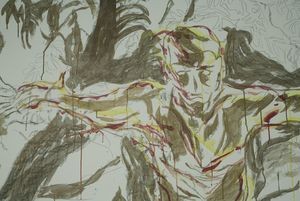Ulrich Hakel, Andreas Hofer, Olaf Metzel
10 Apr - 29 May 2010
ULRICH HAKEL, ANDREAS HOFER, OLAF METZEL
Renaissance der leeren Hand
10.04.10 - 29.05.10
It sounds like an all-star meeting when the three artists Ulrich Hakel (b. 1973), Andreas Hofer (b. 1963) and Olaf Metzel (b. 1952) together, and yet each for himself, create an in situ exhibition for the Kunstraum Innsbruck. Three artist personalities, three generations, three friends, a (super) vision coming under the title Renaissance of the Empty Hand.
It will be exciting to see how Olaf Metzel’s at times brute art, the expressive, comic-like picture rhetoric of Andreas Hofer, and the exuberant, hip hop aesthetic of Andreas Hofer’s wall paintings come together and form a whole. The Kunstraum Innsbruck offers the ideal stage for this kind of experiment, far from the constraints of galleries and museums, and the result, in the truest sense, will constitute a renaissance from the artists’ empty hands toward an ephemeral, i.e. unique, spatial choreography.
Whether the exhibition title Renaissance of the Empty Hand refers to the lonely moment of the artist standing in front of the empty, white wall, or whether, as according to Ulrich Hakel, it is a koan*, this question the artists leave unanswered.
The invitation card makes use of a photograph from the Gallerie dell’Accademia in Venice showing an annunciation scene by Veronese, thus suggesting an art history reference. A central term of the Italian Renaissance was disegno (from Latin designare, meaning designate, draw, outline), which stands for a drawing in the sense of an artistic idea, a blueprint, a spiritual concept, albeit in a religious context. The influence, above all, of the secularisation and the art academies of the nineteenth century reduced the Renaissance concept of the disegno to the quality of a mere tool toward real works of art.
To what extent this or that interpretation or commentary might inform our appreciation in the face of this collaboration, is anyone’s guess. One thing is certain, though. What expects us here is a complex, multi-faceted, and exciting experience.
The artists complement their wall paintings in the main room of the Kunstraum with new works on paper (format A1) that will be shown in the Project Room next door, which are applied collage-like to the walls and also issued as signed and limited-edition art prints.
Stefan Bidner (Curator)
* In Zen Buddhism, a brief paradoxical statement or question used as a discipline in medidation. The effort to solve a koan is designed to exhaust the analytic intellect and the will, leaving the mind open for response on an intuitive level. (Britannica Concise Encyclopedia)
Renaissance der leeren Hand
10.04.10 - 29.05.10
It sounds like an all-star meeting when the three artists Ulrich Hakel (b. 1973), Andreas Hofer (b. 1963) and Olaf Metzel (b. 1952) together, and yet each for himself, create an in situ exhibition for the Kunstraum Innsbruck. Three artist personalities, three generations, three friends, a (super) vision coming under the title Renaissance of the Empty Hand.
It will be exciting to see how Olaf Metzel’s at times brute art, the expressive, comic-like picture rhetoric of Andreas Hofer, and the exuberant, hip hop aesthetic of Andreas Hofer’s wall paintings come together and form a whole. The Kunstraum Innsbruck offers the ideal stage for this kind of experiment, far from the constraints of galleries and museums, and the result, in the truest sense, will constitute a renaissance from the artists’ empty hands toward an ephemeral, i.e. unique, spatial choreography.
Whether the exhibition title Renaissance of the Empty Hand refers to the lonely moment of the artist standing in front of the empty, white wall, or whether, as according to Ulrich Hakel, it is a koan*, this question the artists leave unanswered.
The invitation card makes use of a photograph from the Gallerie dell’Accademia in Venice showing an annunciation scene by Veronese, thus suggesting an art history reference. A central term of the Italian Renaissance was disegno (from Latin designare, meaning designate, draw, outline), which stands for a drawing in the sense of an artistic idea, a blueprint, a spiritual concept, albeit in a religious context. The influence, above all, of the secularisation and the art academies of the nineteenth century reduced the Renaissance concept of the disegno to the quality of a mere tool toward real works of art.
To what extent this or that interpretation or commentary might inform our appreciation in the face of this collaboration, is anyone’s guess. One thing is certain, though. What expects us here is a complex, multi-faceted, and exciting experience.
The artists complement their wall paintings in the main room of the Kunstraum with new works on paper (format A1) that will be shown in the Project Room next door, which are applied collage-like to the walls and also issued as signed and limited-edition art prints.
Stefan Bidner (Curator)
* In Zen Buddhism, a brief paradoxical statement or question used as a discipline in medidation. The effort to solve a koan is designed to exhaust the analytic intellect and the will, leaving the mind open for response on an intuitive level. (Britannica Concise Encyclopedia)

